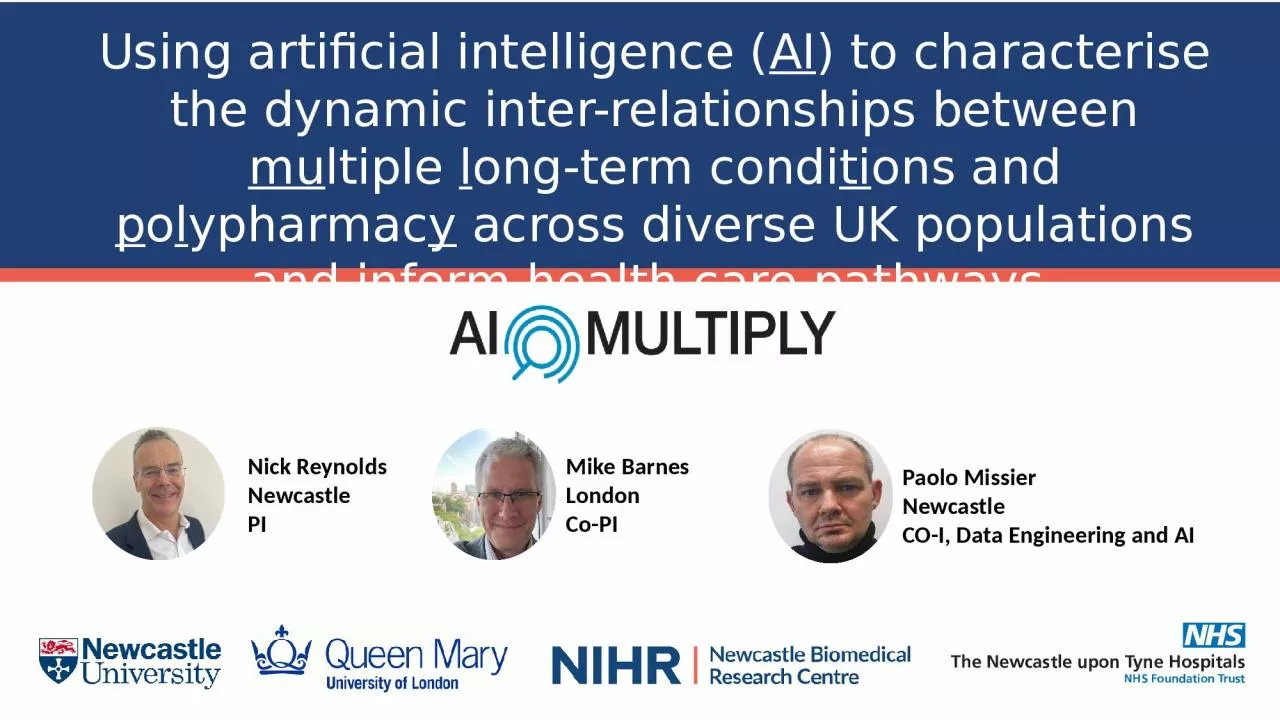

AI to characterise the dynamic interrelationships between mu ltiple l ongterm condi ti ons and p o l ypharmac y across diverse UK populations and inform health care pathways Mike Barnes ID: 1045277
Download Presentation The PPT/PDF document "Using artificial intelligence (" is the property of its rightful owner. Permission is granted to download and print the materials on this web site for personal, non-commercial use only, and to display it on your personal computer provided you do not modify the materials and that you retain all copyright notices contained in the materials. By downloading content from our website, you accept the terms of this agreement.
1. Using artificial intelligence (AI) to characterise the dynamic inter-relationships between multiple long-term conditions and polypharmacy across diverse UK populations and inform health care pathways Mike BarnesLondonCo-PINick ReynoldsNewcastlePIPaolo MissierNewcastle CO-I, Data Engineering and AI
2. PPIEUnderstanding inequalitiesAI for MLTC and polypharmacy clustersInterpretationEthnographic explorationTranslation into practiceSarah FinerDeborah SwinglehurstVanessa ApeaMegan ClinchFiona MatthewsJames WasonTom LawtonAdam ToddNeil WatsonDaniel StowCeri DurhamOlivia GrantJohn IsaacsAlastair BurtHamish McAllister-WilliamGraham KingChris PlummerPaolo MissierSohan SethBarbara HanrattyDexter CanoyNick ReynoldsSoraia SousaData access, wrangling and engineeringMike Barnes
3. Patient lensInequalityPolypharmacyMLTC-M lensAIlenslensImpactPersonalised interventionsDataEngineeringAVADisease-topic definitionsBursty DynamicsReplicateTestDiscoverDatasetsHigh risk groupsExplainableAIResearchCollaboration Development AwardNEWCASTLE NIHR PATIENT SAFETY COLLABORATION
4. AI methodsOutputs & ImpactsDatasetsReplicateTestDiscoverUK-BiobankCPRDGNCRELPREvent spatial & temporal orderEvent CharacterisationEvent PredictionShared standardsPortable pipelinesIdentification of high-risk situations & tipping pointsTrial emulationLocal and national policies (high risk groups)Training & capacity buildingClinical dashboardClinical support toolsNIHR AIM CISCConnected BradfordNIHR AIMOPTIMALImprove patient care Reduce health inequalitiesCommunication of resultsExplainable research &Explainable AILocalHealthIntelligenceDatasetsReplicationDatasetsNationalDiscoveryDatasets>>Within 5 years
5. Data Engineering: Bursty Dynamics and Event TrainsHeterogeneity of inter-event times can be quantified by burstiness parameter BBurstiness may indicate patient deterioration or poorly managed eventsBurst detection methods used to define “event trains” We hypothesise a higher likelihood of causal linkage between events in a train“Seed events” may trigger trainsEvent trains
6. Neural network + xgboost combinationOur readmission cohort is more general vs domain specific cohorts in literatureOur model performs better than current literature in spite of more complex problemPredicting MLTC-PP outcomes: hospital readmissionAdding explanations: which predictors are more relevant to explain unplanned readmission?LTCs and how they accumulatePrescriptions given between discharge and readmission?
7. LTCsAcute EventsPharmacyAgeEvent trainsBurstinessCrisis predictionTPPsBurst seedsAlerting andinterventionGP MLTC-PP status reportsMLTC-PPmonitoringMLTC-PP careplanningClinical dashboardsGPsPharmacistsPopulationlevelIndividual levelPopulation MLTC-PP loadingSummary: Monitoring patient journeys into MLTC-PPLatent Dirichlet Allocation DataEngineeringRon Kremer, Syed Mohib Raza, Paolo Missier et al., Tracking trajectories of multiple long-term conditions using dynamic patient-cluster associations, Procs. IEEE Big Data (BDA4HM), Dec. 2022
8. IEEE BigData 2022Can we model the likelihood of next disease?Experimental models exists for Modelling disease progression [3]Discovering clinical pathway patterns [4]Predicting next disease(s) [5]However, not very robust or actually deployed in practice[3] Wang, Xiang, David Sontag, and Fei Wang. ‘Unsupervised Learning of Disease Progression Models’. In Proceedings of the 20th ACM SIGKDD International Conference on Knowledge Discovery and Data Mining, 85–94. KDD ’14. New York, NY, USA, 2014 https://doi.org/10.1145/2623330.2623754.[4] Huang, Zhengxing, Wei Dong, Lei Ji, Chenxi Gan, Xudong Lu, and Huilong Duan. ‘Discovery of Clinical Pathway Patterns from Event Logs Using Probabilistic Topic Models’. Journal of Biomedical Informatics 47 (1 February 2014): 39–57. https://doi.org/10.1016/j.jbi.2013.09.003.[5] Men, Lu, Noyan Ilk, Xinlin Tang, and Yuan Liu. ‘Multi-Disease Prediction Using LSTM Recurrent Neural Networks’. Expert Systems with Applications 177 (1 September 2021): 114905. https://doi.org/10.1016/j.eswa.2021.114905.use Electronic Health Records (diagnoses event logs) to predict patients’ long-term associations to a specific disease clusterOur goal:
9. Research hypothesisIt is possible to identify clusters of diseases that:Are described using disease terms that are familiar to health domain expertsAre clinically significant based on expert validationAdmit a quantitative association of individual patients with each of the clusters(*) limited to LTCsWhat we hope to find:A significant majority of patients are stable relative to the clusteringStability emerges early in their medical history(*)
10. Disease Clustering: Latent Dirichlet Allocation Use Topic Modelling to generate clusters of diseases based on co-occurrence in patients’ timelinesUsing Latent Dirichlet Allocation Clusters are “topics” defined by ranked lists of disease termsAssociate patients with each of the clusters, at each stage of their disease progressionpatients are strongly / weakly attracted by different cluster as different stages in their medical historyStability: Is there a “steady state” cluster for patients?How early in their medical history can we predict such state?Which disease combinations / sequences lead to predictable steady states?As the timeline progresses…Ron Kremer, Syed Mohib Raza, Paolo Missier et al., Tracking trajectories of multiple long-term conditions using dynamic patient-cluster associations, Procs. IEEE Big Data (BDA4HM), Dec. 2022
11. IEEE BigData 2022ContributionsWe use Topic Modelling as a form of semantic clusteringTopics are defined by ranked lists of disease termsWe define a cluster’s gravitational pull: patients are differently attracted by each cluster at different points in timeWe propose a quantitative measure of stability with respect to clusters over timeWe study how stability increases as timelines progress
12. <event name>Cluster analysis workflowspatients x diagnosesBinary matrixPatients’ medical histories (EHR)Latent Class AnalysisPatient / clusterassociations(discard time)[1,2][2]
13. <event name>Cluster analysis workflowspatients x diagnosesBinary matrixPatients’ medical histories (EHR)Latent Class AnalysisPatient / clusterassociations(discard time)[1,2][2]Disease clusteringEx:Topic Modelling[1]PatientclusteringCluster phenotypingPatientsCross-sectional data {[…]}[1][1,2]
14. <event name>Cluster analysis workflowspatients x diagnosesBinary matrixPatients’ medical histories (EHR)Latent Class AnalysisPatient / clusterassociations(discard time)[1,2][2]Disease clusteringEx:Topic Modelling[1]PatientclusteringCluster phenotypingPatientsCross-sectional data {[…]}[1][1,2]Dynamic patient-cluster associations [5](disease progression over time)
15. Detailed approachPatients timelines(143,000)Topic ModellingOptimal number of topicsCorrecting terms rankings within topicsDynamicPatient-clusterAssociationAssociation vectorsPatient stability analysisPer-stage association changesBag of wordsrepresentationhypertension unspecified_rare_diabetestype_2_diabetescerebrovascular_dz Asthmadiab_neuroObesityCKDESRDNAFLD_NASHCholelithiasisspinal_stenosisallergic_rhinitisHypertensionEnthesopathythyroid
16. Dynamic patient-cluster associations: examplesPatient stages: T1 = [ t1], T2 = [ t1, t2], … Tn = T = [ t1, t2, …. tn]Patient: disease terms sequence T = [ t1, t2, …. tn]IEEE BigData 2022
17. Top 40 disease prevalence for stable/unstable
18. LDA: 4-clusters configurationIEEE BigData 2022
19. Formed our networkAssembled a group of 41 active PPIE membersFuture impact Co-designed PPIE strategyMembers of the public PatientsCarersMental healthDiabetesInflammationInequalities Clarified research priorities & study designPatient voice throughout Early involvement and wide dissemination UK-wide participationPatient advisory groupPatient and Public Involvement and Engagement (PPIE)
20.
21. Ruby DawjiGrainne ColliganInterpretationData access, engineering and AIAlisha AngdembeJohn CasementRebeen HamadMiriam SamuelChristian AtallahRafael HenkinEthnographic explorationSimon WalkerPPIEDuncan ReynoldsTranslation into practiceEllen MossShaun HiuMaharun ChowdhuryProject Management TeamKat RichardsonCarly FlowersBethan KellyIoanna PangouPolly UsherAcknowledgements Lizzie Remfry
22.